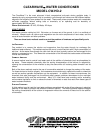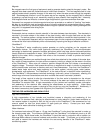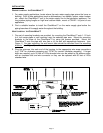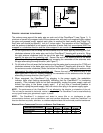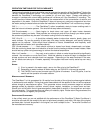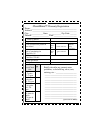
Page 2
Magnets
Bar magnets were the first types of equipment used to generate electric potential changes in water. Bar
magnets have been used with limited success to inhibit scale formation. The fixed magnetic field of a bar
magnet creates electric potential changes in the water only when the water moves through the magnetic
field. Electromagnets function in much the same way as bar magnets, but the magnetic field is created
by passing a current through a coil, essentially creating a more powerful fixed magnetic field. Inherently,
fixed magnetic fields are limited to a narrow range of applications, pipe sizes and water flow rates.
Permanent bar magnets and electromagnets have been promoted as a method of “treating” hard water,
but they do not treat the vast and complex array of mineral contents and concentrations found in water.
Particles can also build up inside the pipe where the magnet is placed, eventually causing blockage at the
very point it is supposed to be doing its job.
Electrostatic Devices
Electrostatic devices create an electric potential in the water between two electrodes. One electrode is
mounted in the water stream in the center of the pipe housing, while the pipe itself acts as the other
electrode. The device applies a voltage across the two electrodes to create the electric potential in the
water. This electrostatic approach was an improvement upon the bar magnets and electromagnets, but
increased the initial cost considerably while not dramatically improving the range of effective conditions.
ClearWave™
The ClearWave™ water conditioning system operates on similar principles as the magnets and
electrostatic devices. But unlike those previously mentioned, the ClearWave™ uses microprocessor
technology to electronically generate inaudible wave-forms which help keep calcium carbonate particles
(scale) dissolved or suspended in water. With ClearWave™, the electric field generated is always being
applied to the water, while a magnetic field relies on the movement of water to produce the electric
potential changes.
Low frequency waveforms are emitted through two coiled wires attached to the outside of the water pipe.
As a result of these waveforms, the two coils are constantly inducing a voltage into the water in the area
of the ClearWave™. When one coil induces a positive voltage the other coil induces a counteracting
negative voltage. This electric field causes the calcium or magnesium to remain in solution or suspension
and the treated water continues to dissolve scale as it flows downstream. Over time, the ClearWave™
treated water helps solve hard water problems in the entire system, including pipes, water heaters,
showerheads, and appliances. The ClearWave™ is the state-of-the-art in electronic water conditioning.
The ClearWave™ microprocessor-controlled technology continually varies its frequency, affecting the
widest range of mineral concentrations and other variables that cause “hard water” problems.
The length of time required to alter the characteristics of the lime scale is dependent on the mineral
makeup of the water being treated. The mineral makeup of the water can impact the operation of the
ClearWave™’s electrical field. A high concentration of iron (soluble and insoluble) causes a disruption
and weakening of the electrical field, reducing the effectiveness on scale reduction. Under these
conditions an iron removal system is required to filter out the iron prior the ClearWave™. Additionally, if
the water is excessively hard (greater than 25 grains), the ClearWave™ is often less effective.
TESTING FOR HARDNESS AND IRON LEVELS
High Iron Concentration
A high concentration of iron (soluble and insoluble) causes a disruption and weakening of the
ClearWave™’s electrical field, reducing its effectiveness on scale reduction. Under these conditions an
iron removal system is required to filter out the iron prior to the ClearWave™. We recommend an iron
removal system for total iron levels above 0.3 ppm (parts per million). Contact your local health
department or water authorities for testing your water
Water Hardness
On hardness levels above 250 ppm or 15 gpg, two ClearWave™ units should be mounted in series on
the incoming water pipe. The maximum hardness level the ClearWave™ will effectively work on is 425
ppm or 25 gpg. Above these levels, the ClearWave™ should be used in conjunction with a tradition ion
exchange water softener to remove hardness and condition the water. This allows you to minimize the
salt used to remove the hardness and maintain the cost saving benefits of the ClearWave™ water-
conditioning system.



